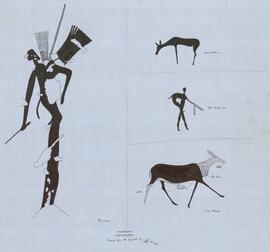Identity area
Reference code
Title
Date(s)
Level of description
Extent and medium
Context area
Name of creator
Biographical history
Created by: stephane
Created on: 23/11/2005
Name of creator
Biographical history
Background of the Recorder
The Rock Art Research Institute had its small beginnings in 1979 when Professor David Lewis-Williams moved from the Social Anthropology Department at the University of the Witwatersrand to the Archaeology Department. A few years later, in 1983, he started a research project focused on surveying and recording the rock art of the Harrismith district, South Africa. This project was headed by Professor Lewis-Williams, with Bruce Fordyce as the only other researcher, and was funded by the Human Sciences Research Council (HSRC). This project grew and the necessity for interpretation of the rock art, not just finding the rock art sites, became a primary focus. In 1986 the entity became more widely recognized and, through a series of successful projects, achieved Unit status becoming the Rock Art Research Unit (RARU), with Professor Lewis-Williams as the director of the Unit. The HSRC still funded the Unit, and additional funding came from the Centre for Science Development, as well as from Wits University. Some of the people employed (full or part time, or as research students) by RARU are Terence Kohler (1984), Conrad Steenkamp (1984), Paul den Hoed (1984-1985), Zachary Kingdon (1986-1987), Colin Campbell (1987-1988), Thomas Dowson (1988-1994), Anne Holliday (1989-1995), Geoff Blundell (from 1993), Sven Ouzman (from 1993). In 2000, with the Professor Lewis-Williams's imminent retirement, Professor Barry Mendelow, then the Deputy Vice Chancellor, suggested that the Unit be ungraded to an institute. A unit is closed if the director leaves, but an institute can continue under different directorship. Institute status is the highest research status conferred by Wits University, and it was awarded to the Unit to recognise the high level of achievement in research publications and the breadth of research talent built up during Professor Lewis-Williams's twenty-one year directorship. Today the Rock Art Research Institute (RARI) is funded by the National Research Foundation, Wits University's own Research Fund and the Anglo-American Chairman's Fund. Some activities have been and are privately resourced. Dr Benjamin Smith became the new director of the Institute after Professor Lewis-Williams. He is still the director today. RARI is dedicated to developing an understanding of rock art by researching indigenous beliefs, rituals, customs and lifeways. Research is currently underway in all South African provinces as well as in Zimbabwe, Swaziland, Lesotho, Botswana, Mozambique, Zambia, Malawi, Tanzania and Kenya. Research therefore includes the rock arts of San and Pygmy hunter-gatherers, Khoi and Nilotic pastoralists, as well as of African farmers, such as the Chewa and the Northern Sotho. Underpinning this diverse research is a focus on the complex symbolism of African image-making. RARI has become one of the largest specialist rock art institutions in the world, attracting students and researchers from around the world. It is a leading centre for rock art training and offers undergraduate and post-graduate courses in rock art recording, interpretation and management. It is also active in rock art conservation and in the development and management of rock art tourism in South Africa. Included in these initiatives is the establishment of the Origins Centre in 2006 (www.origins.org.za), a world-class museum facility located in Johannesburg on the Wits University campus.
Repository
Archival history
Immediate source of acquisition or transfer
Content and structure area
Scope and content
Appraisal, destruction and scheduling
Accruals
System of arrangement
Conditions of access and use area
Conditions governing access
Conditions governing reproduction
Language of material
- English
Script of material
- Latin
Language and script notes
Physical characteristics and technical requirements
Finding aids
Allied materials area
Existence and location of originals
Existence and location of copies
Related units of description
Notes area
Note
Mr van Riet Lowe was a Civil engineer by profession, and from 1923 to 1928, he was in charge of the construction of new bridges in the Free State. It was in this five year period, which he found it crucial for his career, that he supervised the construction of 89 bridges that he had the opportunity to discover over 300 prehistoric sites, mainly in the valley of the Wilger, Vals, Rhenoster, Caledon, Modder and Riet rivers. It was also during this period that a change of profession from Civil engineer to a Prehistoric Archaeologist occurred. Not only had he discovered these sites, but made important collections of artefacts which were then donated to museums in Bloemfontein, Cape Town and the University of the Witwatersrand in Johannesburg. In his interactions in the field of Prehistoric Archaeology, he interacted and collaborated with various scholars, such as Abbe Henri Breuil, A. J. H. Goodwin, with whom he produced The Stone Age Cultures of South Africa. In 1929 Van Riet Lowe had an opportunity to visit some rock art sites in the eastern Free State accompanied by Abbe Breuil. In 1937 van Riet Lowe visited rock art shelter in Northern Rhodesia, now Zimbabwe, including Nachikufu.
By 1928 van Riet Lowe's reputation as a leading archaeologist was firmly established, and by 1935 it was known throughout South Africa and abroad.
In 1935 he represented his Government on the International Historical Monuments Commission of the League of Nations in Geneva and two years later he represented South Africa at the International Conference on Excavations in Cairo.
In 1947 van Riet Lowe took an important part on the deliberations of the First Pan African Congress on Prehistory in Nairobi and the Third Congress in Livingstone in 1954.
Many Honours were conferred upon him: the King's Jubilee Medal (1935), the Queen's Coronation Medal (1954), the South African Medal of the South African Association (1943), the Medal of Voortrekker Monument Committee (1942) and of the Historical Monuments Commission (1956).
Clarence van Riet Lowe died in Knysna in 1956.













